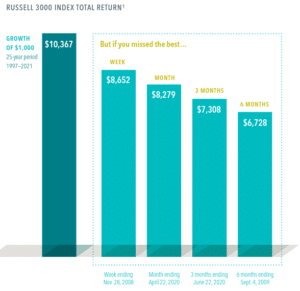I recently attended a conference for financial advisors. For a day and a half, I sat in a room full of other professionals from across the country, each of us eager to gain new insights we might implement for the benefit of our clients.
After hours of presentations and data, including slides upon slides of charts and graphs full of decimal points and percent signs, my biggest takeaway came from a talk by Weston Wellington, Vice President at Dimensional Fund Advisors, titled Stay in Your Seat.
Now, I’m not a big sports person, so bear with me as I make the attempt at the analogy Wellington shared. His friend was attending a soccer game (or is it a match?) he’d traveled a long way to see. By the second half of this highly anticipated event, neither team had scored, and he decided he probably wouldn’t miss much if he left his seat to get a drink. While he was away, his team scored the only goal of the game. They won, and he missed it, all because of a couple minutes out of his seat for a drink he could have lived without.
And this, Wellington explained, is what happens when you get out of your “seat” when it comes to your investments. Your portfolio can suffer greatly, even if you miss only a few of the market’s best days. Take a moment to look at the chart below, or better yet, about a minute to watch this video: Missing the Market’s Best Days.

The Cost of Trying to Time the Market (Dimensional)
Wellington shared dozens of financial news headlines from the 1970s through 2021 from reputable and well-respected publications during his half-hour talk. Nearly every headline was written to evoke fear and uncertainty about our economy and financial futures—some predicting imminent doom and the end of life as we know it.
I admit that even as a professional I felt anxious as I read headline after headline, despite having the gift of hindsight and the knowledge that, over the half-century we discussed, the market grew. And it grew by a lot.
At the end of his presentation, Wellington compared the value of $100,000 invested in the S&P 500 (i.e. stocks) to the same amount invested in US Treasuries (i.e. bonds). In five decades, only once did US Treasuries outperform the S&P 500. The value of the initial $100,000 invested in the S&P 500 in 1970 was over $14 million by 2020, while the $100,000 invested in US Treasuries in 1970 was valued around only $960,000 by 2020.
I fully recognize that my under-illustrated retelling of this presentation is not nearly as impactful as what I witnessed, but my hope is to communicate the main point:
Stay in your seat.
In other words, tune out headlines when it comes to your investments. Instead, control what’s within your control. So, what exactly is in your control?
• Your savings rate—Aim to save (and invest) 20%+ of your gross income.
• Diversification—Invest in a mix of stocks and bonds appropriate for your goals, time horizon, and comfort with risk as well as diversified by geography, sector, size, and style.
• Time in the market—Not to be confused with timing the market, invest as early and as often as possible, and most importantly, stay in the market.
• Cost—Seek low-cost funds and minimize account and transaction fees.
• Sticking to your plan—Make adjustments to your plan based only on the headlines of your personal life, not the headlines in the media.
With all this talk about headlines, I feel it would be a mistake not to acknowledge the tragedy that occurred on Tuesday at Robb Elementary School in Uvalde, Texas. As the mom of a first grader days away from the start of summer break, my heart is broken for the Uvalde community and the parents, family, and friends of the students and teachers who were senselessly murdered. My thoughts and prayers are with them.
Until next time,
Amanda

